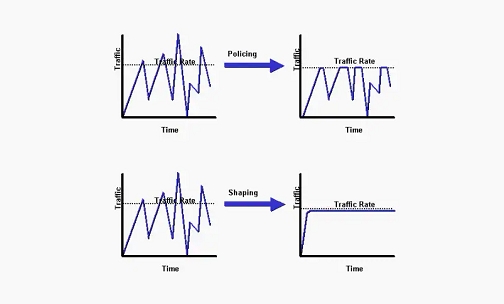Policing Versus Shaping
The following diagram illustrates the key difference. Traffic policing propagates bursts. When the traffic rate reaches the configured maximum rate, excess traffic is dropped (or remarked). The result is an output rate that appears as a saw-tooth with crests and troughs. In contrast to policing, traffic shaping retains excess packets in a queue and then schedules the excess for later transmission over increments of time. The result of traffic shaping is a smoothed packet output rate.

Shaping implies the existence of a queue and of sufficient memory to buffer delayed packets, while policing does not. Queueing is an outbound concept; packets going out an interface get queued and can be shaped. Only policing can be applied to inbound traffic on an interface. Ensure that you have sufficient memory when enabling shaping. In addition, shaping requires a scheduling function for later transmission of any delayed packets. This scheduling function allows you to organize the shaping queue into different queues. Examples of scheduling functions are Class Based Weighted Fair Queuing (CBWFQ) and Low Latency Queuing (LLQ).
For full article click here
